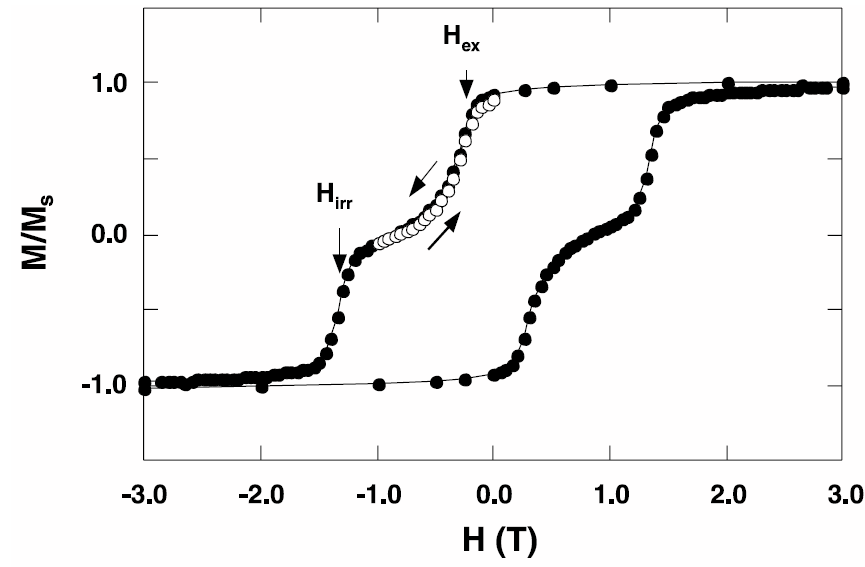Next: 3.2 Theoretical background Up: 3. Multiscale modeling of Previous: 3. Multiscale modeling of Contents
![\includegraphics[height=7.cm]{Capitulo3/Graficas3/thiele}](img484.gif) |
On the other hand, exchange spring magnets have offered an
extraordinary
possibility to control hysteretic properties of composite media by
tuning
extrinsic and intrinsic parameters of different magnetic phases. The
first
work that explained the coercivity of composite thin films with an
exchange
spring mechanism was due to E. Goto et al. [Goto 65]
(see
Fig. 3.2), but Goto did not coin
the ``exchange spring''. The fingerprint of an exchange spring is the
reversible
part of the hysteresis loop between the irreversible jumps that
corresponds to
the motion of the domain wall center towards the hard layer after the
pinning
of the domain wall at the interface. This reversible domain wall motion
can be
clearly observed in the experimental loop shown in Fig. 3.3. This
part would be absent in the case of independent behavior of the
two layers or strongly coupled bilayer. Posteriorly, the exchange
spring mechanism was
proposed by E. Kneller [Kneller 91]
as
a method to increase the energy product
![]() in permanent
magnets. This quantity needs to be maximized in order
to obtain a good permanent magnet. The enhancement of the energy
product was
previously reported in experiments in Ref. [Coehoorn 89]. The hard phase
in permanent
magnets. This quantity needs to be maximized in order
to obtain a good permanent magnet. The enhancement of the energy
product was
previously reported in experiments in Ref. [Coehoorn 89]. The hard phase
![]() was
embedded in the
soft phase
was
embedded in the
soft phase ![]() matrix.
Hence, an important application of exchange spring magnets includes
permanent magnets such as
matrix.
Hence, an important application of exchange spring magnets includes
permanent magnets such as ![]() or
or ![]() where
hard magnetic phase provides high coercivity and soft magnetic phase
provides high saturation magnetization.
where
hard magnetic phase provides high coercivity and soft magnetic phase
provides high saturation magnetization.
 |
Recently, the use of a general composite magnetic bilayer has been suggested for magnetic recording applications [Thiele 03,Guslienko 04,Victora 05a,Suess 05b]. Unlike conventional exchange spring media, perpendicular magnetic recording requires a new type of exchange spring - perpendicular exchange spring (see Fig. 3.4). Differently from permanent magnets, the properties of this composite media should be optimized to provide a relatively low coercive field suitable for conventional recording heads together with high thermal stability [Suess 05b,Dobin 06]. It has been shown that the properties of soft/hard phases could be optimized independently for coercive field and thermal energy barriers values, providing a real alternative for recording media of new generation [Suess 05b,Suess 07]. In comparison to FePt/FeRh material, this general proposal avoids heating process. However, there is an additional requirement of high energy barriers which does not exist in the FePt/FeRh case due to the anti-ferromagnetic character of FeRh at room temperature which itself provides additional thermal stability.
One can expect that the exchange spring mechanism depends on the
coupling
properties between the phases. Real concerns have been expressed on the
possibility to grow soft/hard materials with grain matching in both
layers
[Thiele 04b]. Beside this,
realistic interfaces between two materials present
complicated properties, related to interface roughness, lattice
parameters
mismatch, diffusion of atoms across the interface, etc. All this
situations
contribute to the expectation of a reduced exchange value at the
interface,
which influences the exchange spring performance. The investigation of
soft/hard magnetic layer performance as a function of the
phenomenological interfacial exchange,
![]() constitutes the main
goal of the present chapter.
constitutes the main
goal of the present chapter.